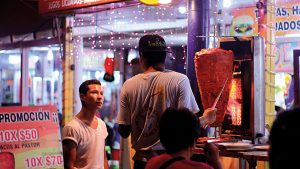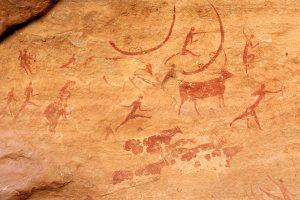Feeding, cooking, sharing
A brief social history of food

This work addresses the food system as a complex structure connected to the environment, like a living organism. It uses the contributions from multiple fields (including anthropology, nutritional, medicine, and economics) to establish connections between analytically disparate fields in order to highlight their transformations over time and space. It also studies social organisation over millions of years to understand the synergy between the environment, extraction technologies, economic and political structures, and the resulting cooking environments (each with their own social construction of tastes) as conditioning factors for sickness and death. In short, it delves into the anthropology of food by relying on three main pillars: critical thinking, a relational approach, and historicity.
Keywords: food, anthropology, history of food, epidemiological transition, characteristic foods.
Introduction
This text will not discuss food – in the sense of substances consumed by humans – too much, but rather, will extensively examine how food organises into meals (where they are intentionally classified, obtained, combined, and subjected to physical or chemical processes which are always shared socially) and cuisines (models, methods, and tools required to obtain a distinctive result). Cuisines characterised eco-cultural regions and nations because they comprise typical foods, with particular combination and preparation processes (recipes), distinctive condiments, and commensality practices.
«We understand food transitions as structural and stable changes that modify food items, meals, and diners»
This article is structured around three transitions. We understand food transitions as structural and stable changes that modify food items, meals, and diners. These shifts are both profound and irreversible; once they take place, there is no going back. Transitions are not unique to food. They are accompanied by large changes in the way we live and think, and the way we create, modify, and destroy social institutions. Each of these transitions also involved a metabolic transmutation; they even changed the bodies of those involved, leading to changes in the diseases they suffered and the ways they died. Each of them is illustrated by a «characteristic food» which – apart from providing material evidence – summarises the commensality practices of a period and marks a milestone from which there is no return (Aguirre, 2017).
Some authors have recognised different sorts of transitions: technological (Kates, 1994), demographic (Luttbeg et al., 2000), epidemiological (Bolaños, 2000), and nutritional (Popkin, 1994). All of them are closely related (as they would be in any other system).

According to authors such as Brunn (2007), the first transition – towards omnivory – made us humans. It was marked by the revolution of meat consumption and the metabolic and social changes that, 2.5 million years ago, put those Palaeolithic species on an evolutionary pathway that placed sapiens as the last offshoot of a tangled tree.
The second transition, which set us up in inequality, was initially driven by a climate change 13,000 years ago, and was marked by two food groups which originated in the processes of domestication: dairy products and cereals. They introduced the possibility of creating artificial ecosystems, allowing the intensification of production and accumulation of surpluses, and created the problem of how to distribute them, contributing to the establishment of distribution processes such as feasts and community chiefs. These transitions deepened societal differences, denying peoples’ rights and leading to exclusion and segregation.
Finally, the third transition, the one we are currently experiencing, is marked by sugar consumption, which went from being negligible and localised to disproportionate and global, modifying societies, economies, bodies, and diseases. We are now immersed in the transition of transitions, the moment when local and global crises in human nutrition compel us to consciously change our lifestyle in defence of society, the species, the planet, and ourselves.
The first transition: the meat revolution
The form of locomotion, reproduction, and feeding conditions the relationship each species has with its environment, and our species underwent profound changes in all three areas. Regarding locomotion, bipedalism changed our relationship with the physical environment. The African savannah favoured those who stood up, thus freeing up their hands, allowing for fine-tuned prehension, improved visual-motor integration, and lower energy expenditure by exposing less body surface to the sun (Leonard, 2002).
In terms of reproduction, continuous sexual predisposition (females can be receptive at any time, not just during oestrus) changed our intraspecific relationships, leading to less competitive groups – without fierce alpha males fighting for individual females (because of their continued receptivity) – and social care for offspring.
In relation to food, omnivory pushed us to obtain nutrients from different sources, changing our relationship with other species in the food chain and turning feeding events into collective and complementary practices. It seems that the Palaeolithic species that preceded us were basically vegetarian, making them prey to the giant carnivores of the Pleistocene. But 2.5-million-year-old fossils show increasing traces of zinc (due to meat consumption) and anatomical modifications (brain, intestines, etc.) suggestive of a change in diet that went beyond just metabolic changes: it drove and was driven by significant behavioural changes.
«All Palaeolithic diets had common characteristics: they were diverse, seasonal, and frugal»
We are a species that went from prey to predator through the use of our own technological and social creations. Because, without powerful claws or fangs, we had to come together, improve our communication, and develop tools to get meat. Opportunism, scavenging, and hunting – in all its different forms – complemented the gathering of vegetables, eggs, and insects. Meat provided us with the nutrients that we were unable to synthesise which were fundamental to our survival. Increasingly specialised stick, horn, and stone tools also point to the modification of our commensal behaviour. The social organization requiered to obtain meat established it as a social good, since our prey anatomy at the time must have made it very difficult for us to become predators.
Environmental dynamics and the relationship with other species in those faraway days left a mark on our bodies which persists even today, where the fast pace of cultural change has left slow biological evolution behind and our surroundings are not the savannah but rather citizen culture. We are better prepared for food scarcity than we are for abundance. Insulin resistance, fatty acid metabolism, long-term stress responses (burning fat), gluten and lactose intolerance, sucrophilia, etc. are evolutionary characteristics that respond to our omnivorous past and its adaptation to changing environments in which we used extractive technology to become a new predator.
Hunter-gatherers: Their life, food, and death
About 50,000 years ago, anatomically modern humans living in hunter-gatherer groups had already colonised every ecosystem (except Antarctica), even reaching insular Australia and glacial America. We have reconstructed their life and diet from archaeological evidence, with some ethnographic references from the last currently surviving groups. This was possible because the entire expansion process from the first agricultural societies was made at the expense of their territories, culture, and lives.
The key for the survival of past and present hunter-gatherer groups is their social organisation with regard to food. A group, even when it is formed by several families, shares the same fire, which is evidence of collective and solidary consumption (reciprocity). Even though harvesting was the (vegetable) basis of their diet, meat became a social good, because hunting – difficult and dangerous – was usually collective. Regarding hunting, reciprocity became the standard form of distribution, thus lowering the risk of depending on mobile resources and activities with random results such as harvesting natural products in extended environments. When there was food, there was food for everyone.

The social organisation required to obtain meat (with the typical anatomy of prey, which otherwise would have made it exceedingly difficult for us to transform into predators), made meats become social goods. The picture shows a cave painting in Tassili n’Ajjer (Algeria), showing a hunting scene. / Patrick Gruban – Flickr
The diet of our ancestors (Eaton, 2007) was nutritionally adequate and abundant. Its effects left a mark on fossil bones, from which we can infer that they had tall, lean bodies that enjoyed good health during their short lives (of approximately thirty years). But we must talk about diets in plural, because the different groups in diverse environments had different foods, which human creativity would turn into different meals. All Palaeolithic diets had common characteristics: they were diverse, seasonal, and frugal. They were also meagre (game was scarce), contained little salt, few carbohydrates, and a lot of fibre (natural vegetables tend to be bitter and fibrous), little sugar (honey and fruit are seasonal foods), and no milk or refined foods (Lindeberg et al., 2004). These diets were the result of Palaeolithic life and we must therefore recognise that the conditions for such a hunter-gatherer economy (the natural animals and vegetables they ate and their social organisation in small groups) are not available today. This is because, in the first place, all the species in our diet have now been domesticated for around 6,000 years, and in the second, reciprocity stove off the risk, so everyone could eat. However, even though it is impossible to reproduce those diets today, they can be useful as models to guide our ideal consumption profile (Montero, 2011).
In Palaeolithic epidemiology, again, diversity was the norm. Because the environments were diverse, infections caused by worms (tapeworm, hookworm) and mosquitoes (malaria, dengue) became a problem in the tropics, but were non-existent in polar climates. But accidents (more frequent and lethal than today), and degenerative diseases (such as arthritis, osteoporosis, and dental wear) were common to all groups. Infectious diseases such as diphtheria, influenza, and measles, were unknown or exceedingly rare in hunter-gatherer societies prior to contact with urban populations. Conversely, arthropod-borne fevers, diarrhoea, gastrointestinal and respiratory diseases, and skin infections were and are still common among these groups (Aguirre, 2017).
The second transition: grains and dairy
13,000 years ago, a five-degree increase in the average temperature melted the glaciers. Forests covered former plains, and the subsequent extinction of species kicked off the greatest resource management programme humanity has ever undertaken: domestication. By domesticating vegetables, small better-controlled ecosystems were created (plots) in which human energy was used to increase yields. Animal domestication, on the other hand, allowed humans to collect milk from the females of other mammals and preserve this milk as yogurt and cheese. This cultural event led to five mutations that now allow us to absorb sugar from milk (lactose), transforming our genotype from intolerant to tolerant, but only in cultures that domesticated milking cattle (Tishkoff et al., 2007).
The characteristics of the cereals and pseudo-cereals that they consumed (the same species as today) brought more stable solutions to the problem of producing food, but had dire ecological (ecosystem homogenisation and frailty), demographic (population increase at the expense of lower quality of life), health (lowering of Neolithic health with a loss of height, decreased intergenesic intervals, and emergence of epidemics), and political and social consequences. If we compare grain planters with tuber planters, we can see to what extent the food we produce conditions our sociopolitical organisation. Unlike grains (Harris, 1985), the perishable nature of tubers pushed for the creation of seasonal redistributive institutions (feasts where individuals eat their fill) to consume food items that could not be stored.
Intensifying ploughing and irrigation allowed these people to increase grain production to overcome seasonal scarcity and produce surpluses. This led to the problem of how to distribute these surpluses: institutions were created that amplified differences between people (social, sexual, age, etc.) and turned them into inequalities. While hunters who specialised in large animals were already characterised by the formation of hierarchical and unequal societies in which male power was the source of all rights, inequality became a consequence of appropriation bias based on the emergence of surpluses; i.e., it became purely cultural. In the new cities, children, women, and other men with limited rights (slaves or servants) were excluded, underfed, and declared inferior, and power was concentrated around the main redistributive institution: the state.
6,000 years ago, city-states emerged in several parts of the world. Despite their many differences, they had common characteristics: they were based on the existence of large (taxable), circumscribed populations (who could not escape) that were hierarchically stratified (according to their appropriation of the agricultural surplus) and specialised (peasants, artisans, warriors, etc.), with administrative levels that coexisted with other less important redistributive circuits (temples, markets) (Berdan, 1991).
All these city-states, with their differences, would later develop differentiated cooking practices because, when there is a hierarchical appropriation of the agricultural surplus, differences in lifestyle appear that obviously also affect cooking. Low cuisine or peasant cuisine was homely, familiar, and female. It was based on a cereal (rice in Asia, maize in America, wheat in Europe) with some vegetables and barely any meat. Today it is worshipped as healthy, but it was born from scarcity (Montanari, 1993). Meanwhile, haute cuisine, in the court or among aristocrats, included every other food, and incorporated exotic items and written recipes, prepared by male cooks who organised banquets for a small number of self-indulgent aristocrats who spared no expense. Roman orgies are an example of this political cuisine, in which food was not only to be consumed, but also to be admired as a reflection of power (Goody, 1985). These cooking practices would break the shared body shape of hunter-gatherers and generate class bodies: the fat rich and the skinny poor, each with their own diseases and causes of death, defining abundance (obesity) and scarcity (malnutrition) pathologies.
The third transition: sugar made us lavish

Even today, sugar is the tracer food for market societies. Despite half a century of healthcare pressure unsuccessfully trying to remove it from our diet due to the extent and consequences of its consumption. This is because virtually all industrialised foods – either processed or ultra-processed – invisibly include sugar to increase palatability and preservation.
The third transition started with the colonial expansion of the main European powers, who found not only gold to fund their development, but also the possibility of cultivating the most expensive food item on their price pyramid: sugar. This crop was based on a plantation and mill system (whose organisation preceded factory production) and used African slave labour. Starting in the seventeenth century, sugar invaded human diets, provided the energy for the industrial revolution and, by distilling sugar musts to produce moonshine, became both a territorial domination weapon and a «proletarian crowd-pleaser» (Mintz, 1996).
Even today, sugar is the characteristic food for market societies, despite half a century of healthcare pressure unsuccessfully trying to remove it from our diet due to the extent and consequences of its consumption. This is because virtually all industrialised foods – either processed or ultra-processed – invisibly include sugar to increase palatability and preservation.
«Rather than agricultural industries, the ones deciding the diet of urban eaters today are 250 highly diversified global holdings»
The transport of species following European colonial expansion reshaped ecosystems, promoting fifteen species at a global scale and destroying local landscapes for the sake of commercial performance. The food industry that emerged from the abundance of sugar transformed foods through preservation, mechanisation, transportation, controlled innocuousness via the use of expert systems, advertising, and marketing through wholesalers and retailers around the world. Rather than agricultural industries, the ones deciding the diet of urban eaters today are 250 highly diversified global holdings (Patel, 2008). Our foods have become goods «to be sold rather than eaten», (Harris, 1989, p. 13), are considered responsible for the noncommunicable chronic diseases that afflict us (diabetes, hypertension), and have caused global pandemics, such as obesity (Chan, 2013).
Devouring the planet
Today’s food crisis appears to be structural (it simultaneously affects production, distribution, and consumption), paradoxical (there is food for everyone and yet 900 million people suffer from malnutrition; FAO, 2018), and terminal (pollution may very well have exceeded the self-purifying capacities of the global ecosystem; United Nations Environment, 2019).

Image: Sharon McCutcheon-Unsplash
In production, we are now facing a quality crisis (too many carbohydrates, fats, and sugars and a critical absence of some micronutrients such as vitamins, iron, and calcium) and a sustainability crisis (should the extractive model of chemical agriculture, pharmacological livestock breeding, and predatory fishing continue, environmental deterioration will impede future production). Because the distribution system responds to market criteria, there is also an equity crisis, and food items end up not where they are needed but rather where people can pay for them, with dire consequences such as overconsumption and underfeeding – both unhealthy outcomes.
Regarding consumption, we are facing a commensality crisis. Industrialised food conspires against identity by replacing shared food and blurring social tables and norms for the sake of constant snacking on so-called UEOs: unidentified edible objects (Fischler, 1995). Eaters might ignore what the packages they buy contain, but some components are always included: plastic, preservatives, flavourings, colourings, sugar, salt, and fat. The norm of our time is to eat alone and constantly consume individually-packaged, unidentified products. This food crisis is the product and producer of social relationships, and has health, environmental, social, political, and demographic consequences.
«We must must beware of simple solutions for complex problems, because the system leaves no room for “silver bullets”»
Although several analyses (Beck, 1998; Giddens & Pierson, 1998) have allowed us to outline policies that try to situate us in the next transition, we must beware of simple solutions for complex problems, because the system leaves no room for «silver bullets». The green revolution and GMOs are examples of solutions that were once considered universal remedies, but systemic processes are much more complicated. We must also be aware of the «pastoral illusion» (going back to the past production systems, ignoring the need for chemistry or science) and the «technological illusion» (expecting new inventions to clean our rivers and arteries), as well as barbaric outcomes (expecting a collapse or, as happened in the past, overcoming the crisis by encouraging differences).
Finally, we must remember that this crisis is social and, as such, human: the result of the way we did things. Therefore, within certain limits, we can act also to reverse it. Before markets end up turning the world into a shopping centre for the few, we might have time to start producing sustainably, distributing equitably, and consuming commensally.
References
Aguirre, P. (2017). Una historia social de la comida. Lugar Editorial.
Berdan, F. (1991). Comercio y mercados en los estados precapitalistas. In S. Plattner, Antropología económica (pp. 116–137). Alianza Editorial-Consejo Nacional para la Cultura y las Artes.
Bolaños, M. V. (2000). Revisión crítica de la teoría de la transición epidemiológica. Papeles de Población, 6(25), 179–206.
Brunn, H. (2007). Meat made us human. In Peter S. Ungar (Ed.), Evolution of the human diet. The known, the unknown and the unknowable (pp. 206–227). Oxford University Press.
Campillo Álvarez, J. E. (2010). El mono obeso. La evolución humana y las enfermedades de la opulencia. Editorial Crítica.
Chan, M. (2013, May 20). WHO Director-General addresses the Sixty-sixth World Health Assembly. https://www.who.int/dg/speeches/2013/world_health_assembly_20130520/en
Eaton, S. B. (2007). Preagriculturals diets and evolutionary health promotion. In Peter S. Ungar (Ed.), Evolution of the human diet. The known, the unknown and the unknowable (pp. 384–394). Oxford University Press.
FAO. (2018). El estado de la seguridad alimentaria y la nutrición en el mundo. https://www.fao.org/3/I9553ES/i9553es.pdf
Fischler, C. (1995). El (h)omnívoro. El cuerpo, la cocina y el gusto. Anagrama.
Goody, J. (1985). Cocina, cuisine y clase. Un estudio de sociología comparada. Gedisa.
Harris, M. (1985). Caníbales y reyes. Los orígenes de las culturas. Alianza Editorial.
Harris, M. (1989). Bueno para comer. Alianza Editorial.
Kates, R. W. (1994). El mantenimiento de la vida sobre la Tierra. Investigación y Ciencia, 219, 92–101.
Leonard, W. (2002). Food for thought. Dietary change was a driving force in human evolution. Scientific American, 287(6), 106–115.
Lindeberg, S., Johnsson, T., Granfeldt, Y., Borgstrand, E., Soffman, J., & Ahrén, B. (2004). A Palaeolithic diet improves glucose tolerance more than a Mediterranean-like diet in individuals with ischaemic heart disease. Diabetología, 50(9), 1795–1807. https://doi.org/10.1007/s00125-007-0716-y
Luttbeg, B., Borgenhoff Mulder, M., & Mangel, M. (2000). To marry again or not: A dynamic model of marriage behavior and demographic transition. In L. Cronk, N. A. Chagnon, & W. Irons (Eds.), Human behavior and adaptation. An anthropological perspective (pp. 345–368). Aldine de Gruyter.
Mintz, S. (1996). Dulzura y poder. El lugar del azúcar en la historia moderna. Siglo XXI.
Montanari, M. (1993). El hambre y la abundancia. Historia y cultura de la alimentación en Europa. Editorial Crítica.
Montero, J. (2011). Alimentación paleolítica en el siglo XXI. Akadia editorial.
Patel, R. (2008). Obesos y famélicos. Globalización, hambre y negocios en el nuevo sistema alimentario mundial. Marea.
Popkin, B. M. (1994). The nutrition transition in low income countries. An emerging crisis. Nutrition Reviews, 52(9), 285–298. https://doi.org/10.1111/j.1753-4887.1994.tb01460.x
Smil, V. (2003). Alimentar al mundo. Un reto del siglo XXI. Siglo XXI.
Tishkoff, S., Reed, F. A., & Ranciaro, A. (2007). Convergent adaptation of human lactase persistence in Africa and Europe. Nature Genetics, 39(1), 31–40. https://doi.org/10.1038/ng1946
United Nations Environment (2019). Global environment outlook – GEO-6: Summary for policymakers. https://doi.org/10.1017/9781108639217





